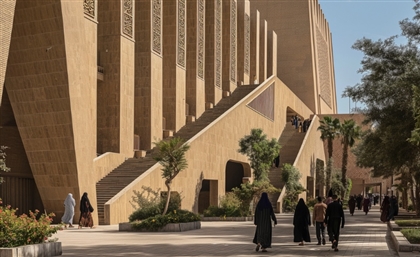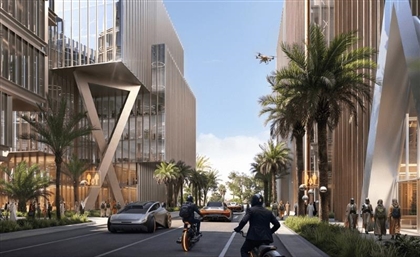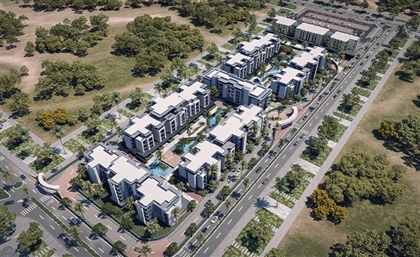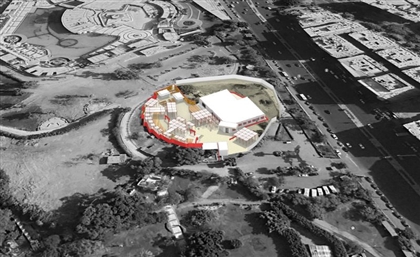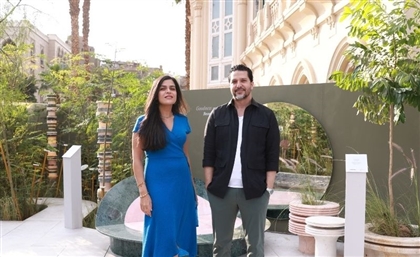Afterlife Designs: How AI Reads Ancient Egypt & Affects Humans
Grossly underrepresented, here’s an interpretation of ancient Egyptian design in high definition.
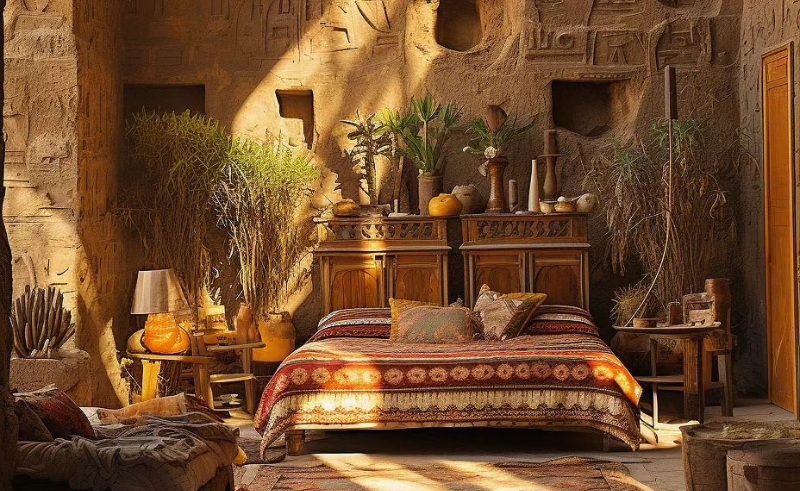
AI-generated imagery got its fair share of attention when it first entered the game. What a high - anything you think of can take visual form, whether it’s mind-bending or numbing, magical or mundane. Stunning recreations and pure imagination took over social media until the fatigue set in, and ethical issues came to light. The disparity between opinions is as stark as the confounding visuals that come out of the digital world.
 That said, these AI images of ancient Egypt are striking. Prompted by Egyptian architect Hassan Ragab, these images feature funerary architecture and contemporary design language. Despite his pride in these ancient Egyptian scenes, Ragab believes that their production is a direct reflection of a serious issue behind AI generation - a worrying lack of documentation. “These are poor interpretations of ancient Egypt,” Ragab tells SceneHome.
That said, these AI images of ancient Egypt are striking. Prompted by Egyptian architect Hassan Ragab, these images feature funerary architecture and contemporary design language. Despite his pride in these ancient Egyptian scenes, Ragab believes that their production is a direct reflection of a serious issue behind AI generation - a worrying lack of documentation. “These are poor interpretations of ancient Egypt,” Ragab tells SceneHome.
 It took a while before Ragab started to share AI generated content relating to Middle Eastern architecture and culture. Not for lack of interest, but rather because of limitations set by the technology - although these limitations have been rapidly changing. “AI tools are upgrading with sonic speed. Midjourney increased the resolution of its already photorealistic model, algorithms are being tweaked and datasets are more inclusive,” Ragab says, referring to the recent updates that allow certain areas - which were previously overlooked - to become more identifiable.
It took a while before Ragab started to share AI generated content relating to Middle Eastern architecture and culture. Not for lack of interest, but rather because of limitations set by the technology - although these limitations have been rapidly changing. “AI tools are upgrading with sonic speed. Midjourney increased the resolution of its already photorealistic model, algorithms are being tweaked and datasets are more inclusive,” Ragab says, referring to the recent updates that allow certain areas - which were previously overlooked - to become more identifiable.
 Out of all the AI tools at his disposal, Ragab found MidJourney had been the most capable of understanding ancient Egypt. “It’s easier for Midjourney to identify ancient Egyptian architecture than Islamic architecture,” Ragab explains. “It’s not comprehensive yet, however. It would get Karnak Temple right but not the Mosque of Ahmed Ibn Tulun. Weirdly, the Sphinx but not Hatshepsut.”
Out of all the AI tools at his disposal, Ragab found MidJourney had been the most capable of understanding ancient Egypt. “It’s easier for Midjourney to identify ancient Egyptian architecture than Islamic architecture,” Ragab explains. “It’s not comprehensive yet, however. It would get Karnak Temple right but not the Mosque of Ahmed Ibn Tulun. Weirdly, the Sphinx but not Hatshepsut.”
 Ragab is constantly exploring the tool’s boundaries. In order to understand why AI can suddenly realise crisp visuals from the distant past, one must understand how it works. “I had to be very specific with prompts in older models. They weren’t able to piece information together and the libraries weren’t expansive,” Ragab explains. “Now, models are strict and confined. What once needed 100 words to explain now takes only ten.”
Ragab is constantly exploring the tool’s boundaries. In order to understand why AI can suddenly realise crisp visuals from the distant past, one must understand how it works. “I had to be very specific with prompts in older models. They weren’t able to piece information together and the libraries weren’t expansive,” Ragab explains. “Now, models are strict and confined. What once needed 100 words to explain now takes only ten.”
 This increased efficiency in dealing with text allowed Ragab’s images to feature a mix and match of different elements, merging ancient Egyptian aesthetics with contemporary settings, including glass curtain walls, modern accessories and furniture. “AI merely draws from building techniques in the past. Ancient Egyptian architecture is funerary, it cares about the afterlife,” Ragab continues, describing the contrasting visuals. “You probably don’t know what their houses looked like but you definitely know their tombs. That’s what the AI understands, afterlife architecture.” AI then transforms the tombs that it is familiar with into a house, a patio or a washroom. “Honestly, I’m not even sure what their washrooms looked like,” Ragab admits, as the AI presents to him that feel relatable but are entirely novel. While it comes with surprise, this endeavour also had its intentional angles.
This increased efficiency in dealing with text allowed Ragab’s images to feature a mix and match of different elements, merging ancient Egyptian aesthetics with contemporary settings, including glass curtain walls, modern accessories and furniture. “AI merely draws from building techniques in the past. Ancient Egyptian architecture is funerary, it cares about the afterlife,” Ragab continues, describing the contrasting visuals. “You probably don’t know what their houses looked like but you definitely know their tombs. That’s what the AI understands, afterlife architecture.” AI then transforms the tombs that it is familiar with into a house, a patio or a washroom. “Honestly, I’m not even sure what their washrooms looked like,” Ragab admits, as the AI presents to him that feel relatable but are entirely novel. While it comes with surprise, this endeavour also had its intentional angles.
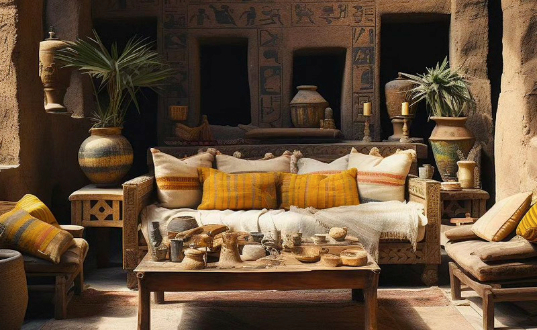 “One of the challenges with ancient Egyptian images is that temples used to be colourful. I mean, think of Dendera and Kom Ombo, they still kept their marvellous colours but the rest is mostly faded,” Ragab says. “I was hoping to bring them back but the dataset is based on what’s available. With AI, you’re limited to what’s documented.”
“One of the challenges with ancient Egyptian images is that temples used to be colourful. I mean, think of Dendera and Kom Ombo, they still kept their marvellous colours but the rest is mostly faded,” Ragab says. “I was hoping to bring them back but the dataset is based on what’s available. With AI, you’re limited to what’s documented.”
 Ragab’s goal was never to imagine an ancient Egyptian house, but instead to push the boundaries of artificial intelligence and see what it’s capable of. “This is a purely conceptual, poor interpretation of ancient Egyptian interiors. It’s not meant to be a home. I wouldn’t live here,” he says. “We’re really far away from any of these to become reality. It still needs processing and thought. Conceptual art to design? That’s a bit excessive.”
Ragab’s goal was never to imagine an ancient Egyptian house, but instead to push the boundaries of artificial intelligence and see what it’s capable of. “This is a purely conceptual, poor interpretation of ancient Egyptian interiors. It’s not meant to be a home. I wouldn’t live here,” he says. “We’re really far away from any of these to become reality. It still needs processing and thought. Conceptual art to design? That’s a bit excessive.”
 Going on this trip back to the future, Ragab wasn’t only experimenting with AI. In doing so, AI was influencing him. “This exploration affected me, it made me aware of just how little I know about ancient Egypt. At times, I felt shameful that I was judging it based on an orientalist’s perspective,” he continues. “Tombs were predominantly documented by foreigners who had their own culture and reflected on our ancient civilisation. The same applies to this tool. It made me start looking at our culture, reading about Shadi Abdel Salam, orientalism and how colonialism influences societies.”
Going on this trip back to the future, Ragab wasn’t only experimenting with AI. In doing so, AI was influencing him. “This exploration affected me, it made me aware of just how little I know about ancient Egypt. At times, I felt shameful that I was judging it based on an orientalist’s perspective,” he continues. “Tombs were predominantly documented by foreigners who had their own culture and reflected on our ancient civilisation. The same applies to this tool. It made me start looking at our culture, reading about Shadi Abdel Salam, orientalism and how colonialism influences societies.”
 Ragab doesn’t have a final destination with his work. He enjoys creating what is seen in a given moment. Like the rest of the world, he’s exploring technology and trying to get somewhere meaningful.“This is big and it’s not a picture that we’re happy with,” he says. “I’m sharing as I explore.”
Ragab doesn’t have a final destination with his work. He enjoys creating what is seen in a given moment. Like the rest of the world, he’s exploring technology and trying to get somewhere meaningful.“This is big and it’s not a picture that we’re happy with,” he says. “I’m sharing as I explore.”
The two posts covering ancient Egyptian interiors garnered considerable attention. The first reached 60,000 people and the second 3,000,000. The only difference being that Instagram’s algorithm favoured one over the other. “It resonated with people because it was viewed by more people, which is weird because the two posts looked similar.”
 Social media algorithms are interchangeable, Ragab simply tries to produce work with quality. Then, again, the reactions have been extreme. People commented dismissing it as nonsense, or claiming that they would sell their souls to ‘live in that house’ (Careful what you wish for - ancient Egyptians likely spent millenia channelling their souls through them).
Social media algorithms are interchangeable, Ragab simply tries to produce work with quality. Then, again, the reactions have been extreme. People commented dismissing it as nonsense, or claiming that they would sell their souls to ‘live in that house’ (Careful what you wish for - ancient Egyptians likely spent millenia channelling their souls through them).
“I’m not trying to ride a wave or catch a trend, I simply want to use AI to push my own boundaries,” Ragab expresses. “Ever since I discovered these tools, I felt that there’s potential we haven’t explored. When we use it to push boundaries the essence becomes about creating something that’s meaningful and withstands the test of time.”
 It’s become easier for users to reach results with great disparity, such as a modern ancient Egyptian interior. It’s a weird mix that sounds even weirder. The models evolve, but more importantly, it’s about how we evolve with it. Ragab can no longer engage with the new model the way he did a month ago; the experience is completely different within a couple of months.
It’s become easier for users to reach results with great disparity, such as a modern ancient Egyptian interior. It’s a weird mix that sounds even weirder. The models evolve, but more importantly, it’s about how we evolve with it. Ragab can no longer engage with the new model the way he did a month ago; the experience is completely different within a couple of months.
“Data sets aren’t entirely better, they’re still biassed. We’re still facing the same issue; it’s much easier to depict architecture in the Western hemisphere than the Eastern. I can produce a building by Zaha Hadid and you won’t be able to tell if it’s real. With ancient Egypt, you’ll know it’s AI. There’s a lack of digital documentation,” he says.
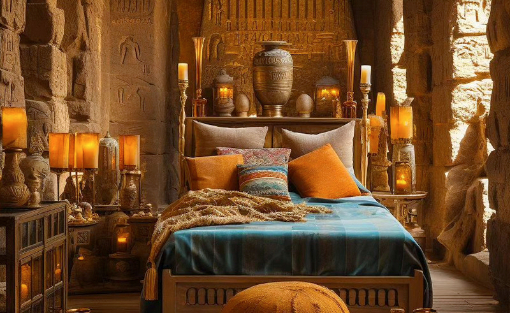 The bias, however, isn’t completely based on discrimination or a lack of documentation. It’s also due to the fact that MidJourney is an artistic tool not an architectural one. It learns from how users interact with it. For example, it produces female portraits much better than male portraits. That’s simply due to the requests and practise it gets.
The bias, however, isn’t completely based on discrimination or a lack of documentation. It’s also due to the fact that MidJourney is an artistic tool not an architectural one. It learns from how users interact with it. For example, it produces female portraits much better than male portraits. That’s simply due to the requests and practise it gets.
Ragab is still in the ancient Egyptian phase of his AI explorations. Even if the posts run their course, these unreal visual generations have ignited a spark within him to continue reading and learning about his country’s past.
- Previous Article The Enduring Charm of Jeddah’s Old Town of Al Balad
- Next Article The Pink Girl Returns Kitsch to the Cairo Home With Eccentric Homeware




